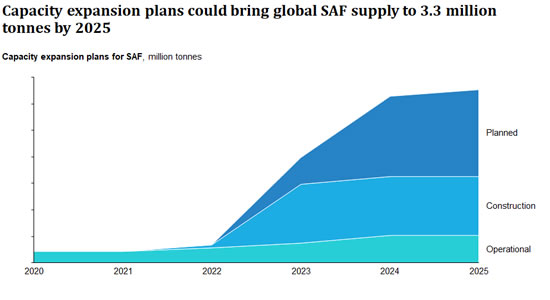London SAF demand to increase more than 30-fold by 2025 as industry decarbonisesFastmarkets projects global demand for sustainable aviation fuel to grow from 80,000 tonnes today to almost three million tonnes by 2025 |
Sustainable aviation fuel (SAF) production will need to more than double every year to meet the global demand for renewable fuel, which is set to be more than 30 times higher in 2025 than current levels, according to new research from Fastmarkets, the cross-commodity price reporting agency.
Current global production stands at about 80,000 tonnes annually. In its latest report Sustainable aviation fuel: The market outlook to 2025 and beyond, Fastmarkets projects that the industry will need to produce around 3 million tonnes a year by 2025 to support the transition to green aviation.
The next few years will need to see government intervention, ongoing airline commitment, a huge increase in raw material supply, technological advancements and significant project financing to meet this period of unprecedented growth in demand.
Regulation and pandemic recovery to drive demand
With the airline industry still recovering towards its pre-pandemic level over the next three years, Fastmarkets forecasts 6% annual growth in air travel from 2024 onwards. Demand for aviation fuel will increase at broadly the same rate, as fuel efficiency only gradually improves. SAF currently accounts for less than 0.05% of this demand, but with increasing pressure from consumers, governments and airlines’ commitments to net zero emissions, this proportion is set to rise to 0.8% by 2025.
Fastmarkets expects two regions to lead in SAF adoption, driven mainly by new government regulation: the European Union and the United States. In its forecast for 2025, it assumes a SAF share of total aviation demand of 2% in Europe and 1% in North America. In Asia Pacific, the region with almost 40% of global aviation and the fastest growth, it assumes just a 0.1% SAF share given a lack of regulatory support in the region for any significant level of SAF adoption.
Supply set to broaden dramatically
To meet growing global demand, production of SAF will need to rapidly expand. Current SAF capacity globally is less than 0.3 million tonnes. Based on announced capacity expansion projects, and interviews with project owners, Fastmarkets expects capacity to expand to almost 3.3 million tonnes by 2025. Of the additional 3 million tonnes of capacity, about 1.1 million tonnes will be from projects already under construction, 1.6 million tonnes from projects that are still in the planning phase, and 300,000 tonnes from existing biofuel facilities ramping up production and converting to SAF.

Increasing SAF production will require a far greater volume of raw materials. Based on announced SAF capacity expansion, at least 80% of the feedstock used to produce SAF in 2025 will be oils and fats – around 60% used cooking oil (UCO), 15% palm fatty acid distillates (PFADs), and 5% virgin vegetable oils. While sourcing adequate raw material at a competitive cost will be a critical challenge for SAF producers, and include establishing new supply chains, the 6 million tonnes of raw materials required to meet anticipated demand in 2025 is modest in comparison to the potential supply.
Achieving cost efficiency will be paramount
While demand and production are forecast to rise, the adoption rate of SAF will be dependent on sufficient investment and production advances to reduce its relative cost. The cheapest SAF currently still costs two to three times more than fossil kerosine. Both consumers and governments have limits to how much and for how long they will fund the adoption of SAF. Therefore, it is essential that SAF production costs are quickly reduced though research, producer learning curves and operations improvement, and up-scaling of facilities.
This requires investment. For instance, new SAF facilities typically cost US$2,000 to US$3,000 per tonne of capacity, and to meet expected demand in 2025, an investment of over US$7 billion will be required over the coming three to four years. This is larger than investment in all biofuel in both 2019 and 2020.
John McGarrity, Senior Editor, Fastmarkets, comments: “Sustainable aviation fuel has emerged as a crucial and tangible step towards decarbonising aviation. Its broad adoption is not a foregone conclusion though, in the face of steep costs and the current lack of production facilities.
"Government support will be vital, and many projects will not go ahead as planned unless the EU and US implements the proposed legislation to drive SAF demand and help close the cost gap between SAF and kerosene. The transition to green aviation and a successful conversion to SAF is dependent upon avoiding a passenger backlash should the price of air travel rise as a result.”

BlueSky Business Aviation News | 16th September 2021 | Issue #621



